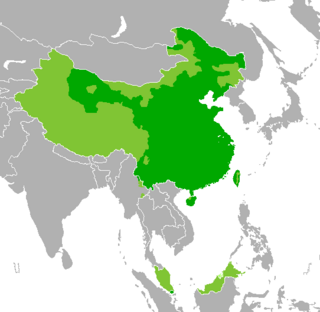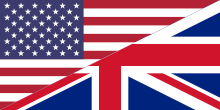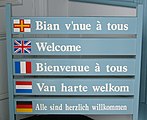
The use of the English language in current and former member countries of the Commonwealth of Nations was largely inherited from British colonization, with some exceptions. English serves as the medium of inter-Commonwealth relations.

A flag is a piece of fabric with a distinctive design and colours. It is used as a symbol, a signalling device, or for decoration. The term flag is also used to refer to the graphic design employed, and flags have evolved into a general tool for rudimentary signalling and identification, especially in environments where communication is challenging. Many flags fall into groups of similar designs called flag families. The study of flags is known as "vexillology" from the Latin vexillum, meaning "flag" or "banner".
H, or h, is the eighth letter in the Latin alphabet, used in the modern English alphabet, including the alphabets of other western European languages and others worldwide. Its name in English is aitch, or regionally haitch.
Sutton SignWriting, or simply SignWriting, is a system of writing sign languages. It is highly featural and visually iconic, both in the shapes of the characters, which are abstract pictures of the hands, face, and body, and in their spatial arrangement on the page, which does not follow a sequential order like the letters that make up written English words. It was developed in 1974 by Valerie Sutton, a dancer who had, two years earlier, developed DanceWriting. Some newer standardized forms are known as the International Sign Writing Alphabet (ISWA).
The tilde˜ or ~, is a grapheme with a number of uses. The name of the character came into English from Spanish, which in turn came from the Latin titulus, meaning 'title' or 'superscription'. Its primary use is as a diacritic (accent) in combination with a base letter; but, for historical reasons, it is also used in standalone form within a variety of contexts.
A query language, also known as data query language or database query language (DQL), is a computer language used to make queries in databases and information systems. In database systems, query languages rely on strict theory to retrieve information. A well known example is the Structured Query Language (SQL).

Sinophone, which means "Chinese-speaking", typically refers to an individual who speaks at least one variety of Chinese. Academic writers often use the term Sinophone in two definitions: either specifically "Chinese-speaking populations where it is a minority language, excluding Mainland China, Hong Kong, Macau, and Taiwan" or generally "Chinese-speaking areas, including where it is an official language". Many authors use the collocation Sinophone world or Chinese-speaking world to mean the Chinese-speaking world itself or the distribution of the Chinese diaspora outside of Greater China.

Franco-Albertans are francophone residents of the Canadian province of Alberta. Franco-Albertans may also refer to residents of Alberta with French Canadian ancestry, although publications from the government of Alberta use the term Franco-Albertan to refer to its francophone residents. In the 2016 Canadian Census, there were 86,705 Albertans that stated their mother tongue was French. In the same census, there were 411,315 Albertans that claim partial or full French ancestry.

In road transport, a yield or give way sign indicates that merging drivers must prepare to stop if necessary to let a driver on another approach proceed. A driver who stops or slows down to let another vehicle through has yielded the right of way to that vehicle. In contrast, a stop sign requires each driver to stop completely before proceeding, whether or not other traffic is present. Under the Vienna Convention on Road Signs and Signals, the international standard for the modern sign is an inverted equilateral triangle with a red border and either a white or yellow background. Particular regulations regarding appearance, installation, and compliance with the signs vary by some jurisdiction.
Guillemets are a pair of punctuation marks in the form of sideways double chevrons, « and », used as quotation marks in a number of languages. In some of these languages, "single" guillemets, ‹ and ›, are used for a quotation inside another quotation. Guillemets are not conventionally used in the English language.

The dollar sign, also known as peso sign, is a currency symbol consisting of a capital "S" crossed with one or two vertical strokes, used to indicate the unit of various currencies around the world, including most currencies denominated "peso" and "dollar". The explicitly double-barred sign is called cifrão in the Portuguese language.
In linguistics, a sprachraum is a geographical region where a common first language, with dialect varieties, or group of languages is spoken.

A bilingual sign is the representation on a panel of texts in more than one language. The use of bilingual signs is usually reserved for situations where there is legally administered bilingualism or where there is a relevant tourist or commercial interest. However, more informal uses of bilingual signs are often found on businesses in areas where there is a high degree of bilingualism, such as tourist venues, ethnic enclaves and historic neighborhoods. In addition, some signs feature synchronic digraphia, the use of multiple writing systems for a single language.

The people of Guyana, or Guyanese, come from a wide array of backgrounds and cultures including aboriginal natives, African and Indian origins, as well as a minority of Chinese and European descendant peoples. Demographics as of 2012 are Indo-Guyanese 39.8%, Afro-Guyanese 30.1%, mixed race 19.9%, Amerindian 10.5%, other 1.5%. As a result, Guyanese do not equate their nationality with race and ethnicity, but with citizenship. Although citizens make up the majority of Guyanese, there is a substantial number of Guyanese expatriates, dual citizens and descendants living worldwide, chiefly elsewhere in the Anglosphere.

Road signs used by countries in the Americas are significantly influenced by the Manual on Uniform Traffic Control Devices (MUTCD), first released in 1935, reflecting the influence of the United States throughout the region. Other non-American countries using road signs similar to the MUTCD include Australia, Indonesia, Ireland, Japan, Malaysia, New Zealand, and Thailand. They, along with the US Virgin Islands, are also the only countries listed here which drive on the left—with the exception of Liberia and the Philippines, both of which drive on the right.

Speech Recognition & Synthesis, formerly known as Speech Services, is a screen reader application developed by Google for its Android operating system. It powers applications to read aloud (speak) the text on the screen, with support for many languages. Text-to-Speech may be used by apps such as Google Play Books for reading books aloud, Google Translate for reading aloud translations for the pronunciation of words, Google TalkBack, and other spoken feedback accessibility-based applications, as well as by third-party apps. Users must install voice data for each language.

The French language became an international language in the Middle Ages, when the power of the Kingdom of France made it the second international language, alongside Latin. This status continued to grow into the 18th century, by which time French was the language of European diplomacy and international relations.
English-speaking Quebecers, also known as Anglo-Quebecers, English Quebecers, or Anglophone Quebecers or simply Anglos in a Quebec context, are a linguistic minority in the francophone province of Quebec. According to the 2011 Canadian census, 599,225 people in Quebec declare English as a mother tongue. When asked, 834,950 people reported using English the most at home.


























